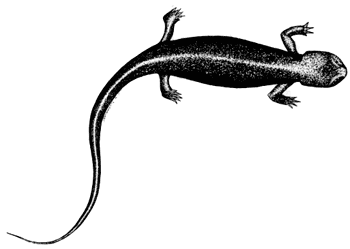Adventures with Park Amphibians
The average visitor to Crater Lake National Park is oblivious of the amphibian population in the vicinity of the lake; and the statement that frogs are numerous behind park headquarters or that salamanders abound at the lake edge seldom fails to bring an expression of surprise. “I’d have thought it was too cold up here for frogs and salamanders.” Amazing as it may seem, Crater Lake has a large representation of these lowly creatures that seem to thrive in the cold, for several of our species are found only at high altitudes.
Soon after my arrival in the park I was surprised to hear croakings coming from the marsh behind park headquarters. The marsh was still largely covered by snow and it was difficult to believe that frogs were active so early in the season. I fitted myself with a light and investigated. Following up the course of one of the streams, I discovered a female frog squatting in a hole under the opposite bank. Later I located two males by their croaking. In spite of the cold that numbed my hands these amphibians were quite agile. I collected them, and then, to my utmost surprise, I found several egg masses. These frogs were not only out and active, they were breeding! Identification showed my specimens to be Cascade frogs, Rana cascadae, an inhabitant of high altitudes in the Cascades.
I revisited the egg masses the following day. Each egg was about one-third inch in diameter, with transparent coats and a dark embryo in the center. A single mass consisted of several hundred eggs, all encased in jelly. I watched their development during the next few days as the embryos increased in size and became motile within their coats. On the 9th day the tadpoles freed themselves of the encumbering egg coat to take up a free life in the stream.
The same night I found the Cascade frogs, I flashed my light into a small burrow in the marsh and saw a white throat swelled out to the size of a marble. I recognized a Pacific tree frog, Hyla regilla. It was truly a shock to find this pretty little fellow out so early in the season, for I was accustomed to collect them in the San Francisco region in temperatures far higher than those associated with freezing nights and melting snows. This Hyla is a jewel among frogs with his vivid green back, white throat and belly, and black eye patch. On the end of each toe is an adhesive disk to serve in climbing, enabling him to walk up a pane of glass. In spite of his small size, only an inch from snout to vent, Hyla has a mighty voice. He puffs out his throat and emits a bleat that may be heard a half mile away. Later I saw several of these frogs among the boulders in Wizard Island, but they were so adept at diving into crevices that I was unable to capture a specimen.
The common northwestern toad, Bufo boreas boreas, is abundant in the Rim Area, but this member of the clan is so familiar to most everyone that it is unnecessary to discuss him here.
The salamanders of Crater lake are probably the most interesting of the Amphibian inhabitants. Although salamanders show a superficial resemblance to lizards it has been said that they are no more closely related to them than we are. The more apparent differences between the two is that a lizard has scales and lives in dry places, whereas a salamander dies if subjected to drying. Salamanders are more sluggish than most lizards and must deposit their eggs in water and pass the first stage of life as gilled larvae. The anatomical differences between them are most striking of all, but are principally significant to specialists.
The two species of salamanders found at Crater Lake are taken under stones at the water’s edge where they live, apparently harmoniously, together. The more numerous type is the Crater Lake newt, Triturus granulosus mazamae, which has been taken only at Crater Lake. He is black, about eight inches long, with granular skin and a brilliant orange underside. His less-common companion is the long-toed salamander,Ambystoma macrodactylum, named for his unduly long digits. He also is black except for a line of yellow down the back; his skin is smooth and glistening.
In the middle of July an overturned rock revealed these animals in knots of five or six individuals all clinging together. The ratio was about ten Triturus to one Ambystoma.Considering the greater agility of the latter, I had far more Triturus to show for my efforts than Ambystoma. It is of interest to note that a search under the rocks on the first of July had failed to reveal any specimens. Thus, they must have congregated there sometime between the first and the middle of the month. It is my presumption that they winter under logs, rocks, and other objects away from the lake shore, and gather nearer the water for breeding.


